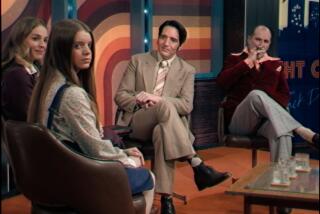Glug, glug
- Share via
Fifteen years ago, I had a stupid idea.
I was the co-executive producer on TV’s long-running comedy “Cheers.” NBC, the network on which “Cheers” appeared, was faltering: Ratings were sliding, money was tight, management was nervous and the then-king of late-night television, Johnny Carson, legendary host of the “Tonight Show,” was retiring, and no one knew how his replacement, Jay Leno, would do.
I was 28 then, and like all 28-year-olds, I had no idea exactly how stupid I was. So when I found myself standing next to the president of NBC during the filming of an episode of “Cheers,” I offered my solution to his network’s crisis.
“You know what you should do?” I said, brimming with self-assurance. “You should move the ‘Tonight Show’ with Jay Leno to 10 p.m. Think of all the money you’d save.”
“That’s a pretty stupid suggestion,” he said to me.
Only, in those days, network presidents tended to be earthier types with show-business vocabularies, so he inserted a colorful Anglo-Saxon expletive between the words “pretty” and “stupid.” He then went on to explain, in a tone of voice used for the very old, the very young and the developmentally disabled, the complicated ecosystem of broadcast television, the maze of clearances and station groups and agreements that rendered such a move not only legally impossible but financially ludicrous. The five hours of prime-time weeknight programming between 10 p.m. and 11 p.m. are immensely lucrative, he explained, and hugely popular with advertisers. Cutting them out would be suicide.
“The day we have to do that,” he wound up, “is the day we have to shut the whole thing down.”
Only he inserted a colorful Anglo-Saxon expletive between the words “whole” and “thing.”
This month, the president of NBC announced that the network is moving Jay Leno to 10 p.m. with a show format very similar to the “Tonight Show.” Which only proves that the difference between a stupid business idea and a brilliant business idea is 15 years and an economic collapse.
When I learned this news, I was on board the merchant vessel Hanjin Miami, a container ship plying the North Pacific trade route, making a bumpy, stormy passage between Seattle and Shanghai. I booked a cabin for the three-week crossing because I had some writing to do, and I’ve discovered that I’m incapable of doing any kind of focused, uninterrupted work as long as there’s a cellphone to ring, an e-mail to read or the Web to surf. The isolation has been very productive.
But late one night, slipping through the narrow strait between the island of Hokkaido and the main Japanese island of Honshu, the iPhone came to life. Cell towers along the Japanese coast zapped weeks’ worth of voice mails and e-mails and text messages, and like some kind of connectivity junkie, I sat in my cabin in my underwear and clicked and scrolled and caught up with life. Well, with e-life.
The online edition of the L.A. Times filled me in on the volatile Dow, on the shaky auto industry bailout, on bad Christmas retail projections. Variety.com brought me news of entertainment industry layoffs, of advertising rate implosions and the “Hail Mary” Leno shift. Sitting there in my cabin, I muttered darkly to myself, “They might have to shut the whole thing down.”
And I added the modifier too. I’m a merchant seaman, after all. Of course, I didn’t really have to hear bad economic news from Variety.com or latimes.com. The Hanjin Miami is a giant, floating, diesel-powered economic indicator. In fat times, it carries 7,000 containers from China to the West Coast of the United States, each one stuffed with flat screens and polo shirts and iPods and toys and jeans and every kind of extruded plastic doodad imaginable. They line the shelves of Wal-Mart and Best Buy and PetSmart, and we snap them up and send the empty containers back to Asia for a refill. Ideally, of course, we’re supposed to send full containers back, filled with our stuff for them to buy, but we don’t make much stuff anymore. We make complicated financial products and arcane debt instruments. Or did.
In fact, we don’t even make the ships that carry the containers. The Hanjin Miami was built by Hyundai, in South Korea, and is operated by a German company and chartered by the South Korean shipping outfit Hanjin. Which means other people not only make the computers and clothes and sneakers that fill the containers, they also make the 90,000-ton steel behemoth that carries it all to our door. We, on the other hand, have invented Twitter. And Cinnabon.
But these are lean times. The Pacific trade is slowing down. Demand in the United States is plummeting, which means fewer trips, fewer containers -- both full and empty -- and no need to burn expensive fuel making a fast crossing. We anchored off the coast of South Korea for five days to save fuel and port charges. No one’s waiting for empty containers in China because no one’s waiting for full containers in Long Beach. With less stuff to buy in the stores, there’s less stuff to advertise on television. And when advertising revenues go down, things go haywire. Anything can happen. Hollywood executives get laid off. Jay Leno moves to 10 p.m.
It turns out I didn’t need to wait for cell coverage to tell me that. I didn’t need to read it online. I could have just stood on the deck of the Hanjin Miami, looked at the empty containers and connected the dots.
Feel free to insert a colorful Anglo-Saxon expletive between “the” and “dots.”
More to Read
The complete guide to home viewing
Get Screen Gab for everything about the TV shows and streaming movies everyone’s talking about.
You may occasionally receive promotional content from the Los Angeles Times.






